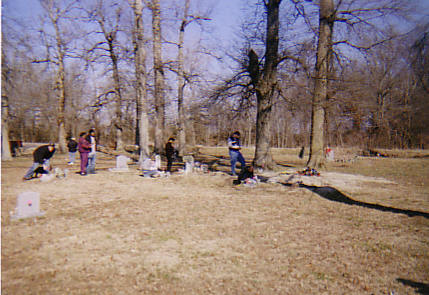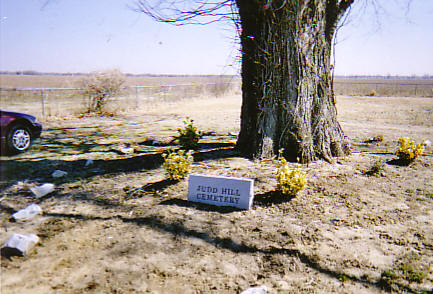
|
|
|
|
Judd Hill Heritage Project: Preserving the African American Legacy in NE Arkansas Tulot Cemetery (Site # 3PO618) February 21, 2004 Photos taken by Mattie Wortham of Judd Hill Memorial Scholarship Fund

Figure 1 View Looking North Deric Wyatt, Stephanie Shearman, Merlyn Jones,David McClain, Heather Dapp, Faisal Khokkar, Bill Bailey, John Gilbee
Judd Hill Cemetery (Site # 3PO617) February 28, 2004 Photos taken by Mattie Wortham of the Judd Hill Memorial Scholarship Fund

Figure 6 View Looking Northeast Judd Hill Cemetery Marker replacing original wooden marker that was burned
The Judd Hill Plantation Project By Dr. Julie Morrow Station Archaeologist-ASU In December 2003, the ASU Station of the Arkansas Archeological Survey learned that two African-American cemeteries were in need of help. During the Spring 2004 semester, we undertook the documentation of two cemeteries in Poinsett County that are part of the old Judd Hill Plantation (Figure 1 and Figure 6). The Tulot and Judd Hill Cemeteries are among the few extant African American cemeteries in Poinsett County, Arkansas. Today, the standing structures that are part of the original Judd Hill Plantation include an old store (now used as an office), the original brick gin, a blacksmith’s shop, granaries, machine sheds, barns, Orange Judd Hill’s original bungalow and a large , two story house built later, possibly in the 1930s. Orange Judd’s brother, Billy Hill owned land to the south of the Judd Hill Cemetery. This parcel, called Billy Hill, was where white sharecroppers lived. The land that once encompassed the Judd Hill Plantation is now divided between two trusts (the Purvis Trust and the Judd Hill Foundation Trust) both of which rent the land to local farmers who grow cotton, rice and beans. In 1995 the Judd Hill Memorial Scholarship Committee was formed http://www.clt.astate.edu/dsc/Juddhill.html. The Committee consists of Mattie Wortham, Sylvester Wortham (Vice-president), Elaine Williams (secretary), Merlyn Jones (treasurer), Willie Burns (member), Aaron Jones (member), and Laquita Williams (member). At that time, the committee started a scholarship at Trumann High School to encourage African American students to pursue higher education. Some of the students are descendants of sharecroppers of the Judd Hill Plantation. Until the late 1970s, the Judd Hill Plantation was a thriving farming community. According to Mattie Wortham, who has been documenting the history of the Plantation since 1995, there were once two churches that also served as schools and many sharecropper dwellings. This was confirmed through our analysis of historic and modern maps, and aerial photos. But the only above ground evidence of the African-American culture that worked the land and built the plantation are two severely damaged cemeteries. The Judd Hill Memorial Scholarship Committee is attempting to preserve the Tulot and Judd Hill cemeteries to honor their heritage and preserve history for the descendants of the Judd Hill Plantation. On December 18, 2003, Mattie Wortham took Julie Morrow and Debbie Anderson of the Arkansas Archeological Survey and Ken Heard, a reporter from the Arkansas Democrat-Gazette, on a tour of the Tulot and Judd Hill cemeteries. She told us about the trials and tribulations that she and her committee had gone through since 1995 in their attempt to preserve and protect the Judd Plantation cemeteries. Mattie is a descendant of the late Reverand C. C. and Mattie Scott both interred at Tulot Cemetery. Two of her brothers are buried at Judd Hill Cemetery. Mattie received a small planning grant from the Arkansas Humanities Council for background research necessary for placing the Tulot and Judd Hill cemeteries on the National Register of Historic Places. She needed to know the size of each of the cemeteries and so called the Survey for help. During the initial visit in December we observed many damaged headstones and numerous grave-sized depressions without headstones (Figure 3, Figure 4 and Figure 8). Both cemeteries were grave-sized areas where soil had been recently deposited, some of these had plant stands or flowers associated with them. It was clear that there were many unmarked graves within the confines of the cemeteries. The vandalism we witnessed and the missing headstones are partially due to the fact that very few descendants of the Judd Hill plantation live close enough to these cemeteries to effectively protect them. Additional damage noted during our initial visit was the encroachment of the farm field and county roads toward the Tulot cemetery. At the Judd Hill cemetery, the existing perimeter fence of chain link has been broken in two places (along the east and south sides) and a large area of standing water from a center pivot has potentially caused the ground to sink. Due to the presence of thick vegetation and potential ground sinking caused by water and/or farm equipment or possibly some other process, it was not possible to determine whether there were depressions representing graves in this area of the site. Remote sensing could determine the presence of below ground features such as graves. Remote sensing is a set of tools routinely employed by archaeologists to detect below disturbances below the ground. On Saturday, February 21st and February 28th 2004, Arkansas State University students from three classes: ANTHRO 3203: Introduction to Archaeology, ANTHRO 3233: Native American Cultures of the Mid-South, and GEOL 1003: Environmental Geology documented existing cemetery headstones at Tulot and Judd Hill Cemetries using a standardized headstone recording form. Headstone locations and perimeter corners of the cemeteries were mapped by Deric Wyatt of the Arkansas Highway and Transportation Department. Students helping with the fieldwork include: Andrea Brower, Debbie Anderson, Bill Bailey, Lauren Dapp, Heather Dapp, Linda Fielding, Faisal Khokkar, Stephanie Shearman, and Autumn Thomas. Mr. Mike Gibson who had given us permission to survey the Judd Hill Plantation, attended the February 28th fieldwork at the Judd Hill cemetery. It was warmer than the previous week, and sunny. John Thomas (AAS-ASU) and Mattie Wortham took photographs. At both of the cemeteries, we placed numbered pin flags at each headstone, depression, or soil piles atop graves. Basic data recorded for each headstone included GPS location, height, width, and thickness of base and top of headstone, direction the headstone faced, whether the headstone was at the foot or the head of the burial, raw material (limestone, sandstone, granite, etc.), date of birth, date of death, inscription, damage, who recorded the information, and the date the information was recorded. At Tulot cemetery we documented 80 depressions and soil piles, only 22 were marked with headstones. Some had flowers or flower stands. The cemetery measured 2,218 square meters. At the Judd Hill Cemetery we mapped 92 depressions or hilled up areas, only 31 were marked with headstones, but as at the Tulot cemetery, there were some areas that we assumed were graves based on soil characteristics; some of these had flowers or flower stands. At Judd Hill cemetery the oldest existing headstone is associated with Ethel Stephenson, born November 27, 1890 and deceased October 19, 1942. The most recent headstone is that of Booker Childs born August 24, 1919 and died May 25, 2003. At Tulot cemetery, the oldest headstone is that of Lucy Mott born February 23, 1881, deceased September 16, 1941. The most recent grave is that of Bernest Nixon, Jr. born in 1965 and died in 2003. Information gleaned from archival sources, however, indicates that the cemeteries have been used far longer than is indicated by the existing headstones.
|
|
This website is maintained by Dr. Julie Morrow, jmorrow@astate.edu This page was last updated on August 10, 2005 |